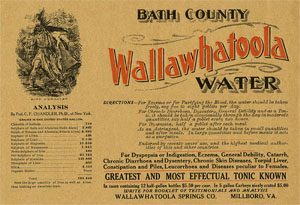The River
 The Cowpasture River has a rich history. It was originally named “Wallawhatoola” (or Walatoola by some accounts) by the Native Americans. Interpreted as “winding waters,” the term aptly describes its meandering path when traveling through much of Bath County. In the early 1700’s, the area was not permanently inhabited. The Shawnee still hunted there and managed the land, burning the river bottoms periodically to promote habitat for their food sources such as buffalo and elk. The first European/American settlers were largely members of dissenting protestant sects, including Scots-Irish Presbyterians, who had fled religious persecution elsewhere. One of the founding families was that of John Lewis in the 1740s, followed by his son Charles. As the area developed with roads fording the river at various locations, it was dominated by large farms that were often held in families for generations. The remote, mountainous location and rural nature of the Cowpasture River watershed has served over the years to protect the area somewhat from the rampant development seen in the Shenandoah Valley and points east. Today, the river is bounded mostly by farms, summer camps, hunting and fishing camps, and year-round residences.
The Cowpasture River has a rich history. It was originally named “Wallawhatoola” (or Walatoola by some accounts) by the Native Americans. Interpreted as “winding waters,” the term aptly describes its meandering path when traveling through much of Bath County. In the early 1700’s, the area was not permanently inhabited. The Shawnee still hunted there and managed the land, burning the river bottoms periodically to promote habitat for their food sources such as buffalo and elk. The first European/American settlers were largely members of dissenting protestant sects, including Scots-Irish Presbyterians, who had fled religious persecution elsewhere. One of the founding families was that of John Lewis in the 1740s, followed by his son Charles. As the area developed with roads fording the river at various locations, it was dominated by large farms that were often held in families for generations. The remote, mountainous location and rural nature of the Cowpasture River watershed has served over the years to protect the area somewhat from the rampant development seen in the Shenandoah Valley and points east. Today, the river is bounded mostly by farms, summer camps, hunting and fishing camps, and year-round residences.
The Organization
The Cowpasture River Preservation Association (CRPA) was organized in 1972. It originated from a group of advocates for the river who felt that there were impending threats from large governmental and corporate development projects either underway or planned for the local region at that time. Today it is formally incorporated and a 501(c)3 not-for-profit organization. Over the years, the mission of protecting the river has remained the same, but its objectives have grown from one primarily of advocacy to, at present, encompassing educational and water quality monitoring programs as well as outreach activities. All are designed to inform the public about best practices in good watershed stewardship. The CRPA partners with agencies and other nonprofits toward mutual goals of watershed conservation. The organization is made up entirely of volunteers with the exception of one paid staff member. The CRPA includes over 300 members who work to keep the river clean, pristine, healthy, and brimming with flora and fauna. Governance is provided by a 15-member Board of Directors, from Highland, Bath, and Alleghany Counties. Anyone with a love of and/or concern for the river is welcome to become a member.

